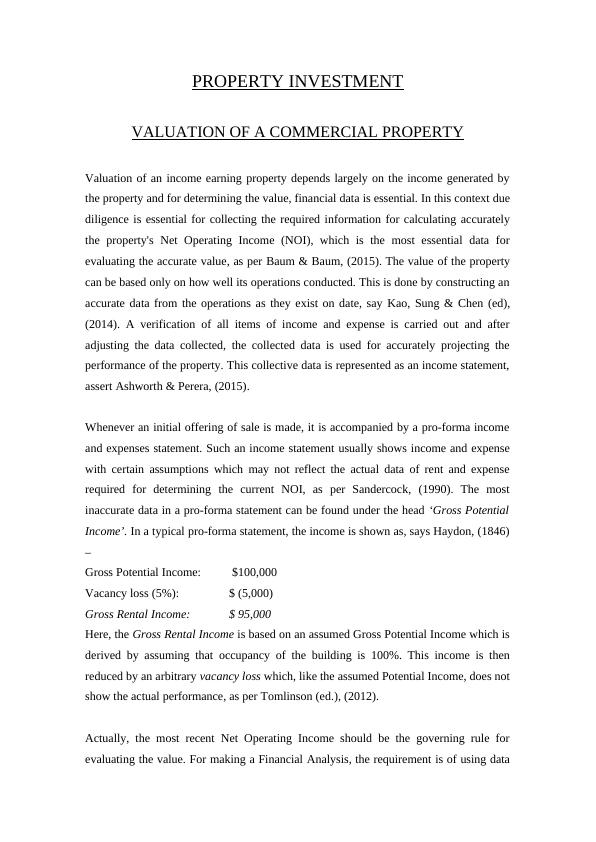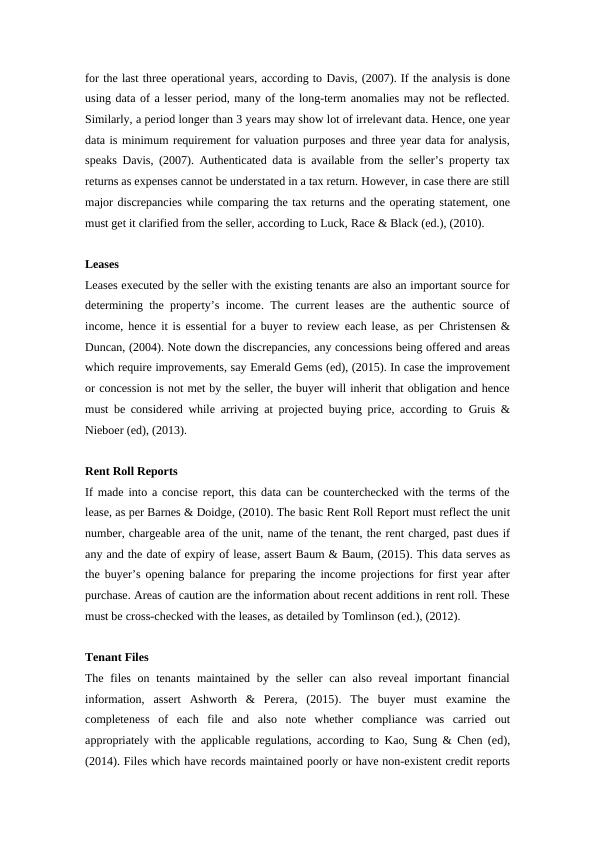Ask a question from expert
Commercial Property Valuation: Methods and Case studies
9 Pages3439 Words248 Views
Added on 2021-05-31
Commercial Property Valuation: Methods and Case studies
Added on 2021-05-31
BookmarkShareRelated Documents
PROPERTY INVESTMENTVALUATION OF A COMMERCIAL PROPERTYValuation of an income earning property depends largely on the income generated bythe property and for determining the value, financial data is essential. In this context duediligence is essential for collecting the required information for calculating accuratelythe property's Net Operating Income (NOI), which is the most essential data forevaluating the accurate value, as per Baum & Baum, (2015).The value of the propertycan be based only on how well its operations conducted. This is done by constructing anaccurate data from the operations as they exist on date, say Kao, Sung & Chen (ed),(2014). A verification of all items of income and expense is carried out and afteradjusting the data collected, the collected data is used for accurately projecting theperformance of the property. This collective data is represented as an income statement,assert Ashworth & Perera, (2015).Whenever an initial offering of sale is made, it is accompanied by a pro-forma incomeand expenses statement. Such an income statement usually shows income and expensewith certain assumptions which may not reflect the actual data of rent and expenserequired for determining the current NOI, as per Sandercock, (1990). The mostinaccurate data in a pro-forma statement can be found under the head ‘Gross PotentialIncome’. In a typical pro-forma statement, the income is shown as, says Haydon, (1846)– Gross Potential Income: $100,000Vacancy loss (5%): $ (5,000)Gross Rental Income:$ 95,000Here, the Gross Rental Income is based on an assumed Gross Potential Income which isderived by assuming that occupancy of the building is 100%. This income is thenreduced by an arbitrary vacancy loss which, like the assumed Potential Income, does notshow the actual performance, as per Tomlinson (ed.), (2012).Actually, the most recent Net Operating Income should be the governing rule forevaluating the value. For making a Financial Analysis, the requirement is of using data

for the last three operational years, according to Davis, (2007). If the analysis is doneusing data of a lesser period, many of the long-term anomalies may not be reflected.Similarly, a period longer than 3 years may show lot of irrelevant data. Hence, one yeardata is minimum requirement for valuation purposes and three year data for analysis,speaks Davis, (2007). Authenticated data is available from the seller’s property taxreturns as expenses cannot be understated in a tax return. However, in case there are stillmajor discrepancies while comparing the tax returns and the operating statement, onemust get it clarified from the seller, according to Luck, Race & Black (ed.), (2010).LeasesLeases executed by the seller with the existing tenants are also an important source fordetermining the property’s income. The current leases are the authentic source ofincome, hence it is essential for a buyer to review each lease, as per Christensen &Duncan, (2004). Note down the discrepancies, any concessions being offered and areaswhich require improvements, say Emerald Gems (ed), (2015). In case the improvementor concession is not met by the seller, the buyer will inherit that obligation and hencemust be considered while arriving at projected buying price, according to Gruis &Nieboer (ed), (2013).Rent Roll ReportsIf made into a concise report, this data can be counterchecked with the terms of thelease, as per Barnes & Doidge, (2010). The basic Rent Roll Report must reflect the unitnumber, chargeable area of the unit, name of the tenant, the rent charged, past dues ifany and the date of expiry of lease, assert Baum & Baum, (2015). This data serves asthe buyer’s opening balance for preparing the income projections for first year afterpurchase. Areas of caution are the information about recent additions in rent roll. Thesemust be cross-checked with the leases, as detailed by Tomlinson (ed.), (2012).Tenant FilesThe files on tenants maintained by the seller can also reveal important financialinformation, assert Ashworth & Perera, (2015). The buyer must examine thecompleteness of each file and also note whether compliance was carried outappropriately with the applicable regulations, according to Kao, Sung & Chen (ed),(2014). Files which have records maintained poorly or have non-existent credit reports

are to be thoroughly verified. A tenant without reference from the previous landlord canbe the source of trouble in the future, explain Luck, Race & Black (ed.), (2010).ANALYSIS OF A COMMERCIAL PROPERTY INVESTMENTDevelopers and investors have to be cautious with the feasibility study during thepreliminary stages of a deal, since a building deal requires huge investments of capital,as per Emerald Gems (ed), (2015). In order to prevent the deal from failure, an officedevelopment scheme, particularly in the current turbulence property market. Hence, afeasibility study can play an important role in successfully implementing the project, asper Christensen & Duncan, (2004).Because there is involvement of huge amount of funds, whichever approach ofassessment is used, it is essential to take into account factors such as location, rentalincomes and operational expenses of the office development, say Gruis & Nieboer (ed),(2013). As is discussed in this paper, there are two approaches used while assessing thefinancial analysis of the office development. In Australia, Capitalisation of IncomeApproach is the most widely used methodology, according to Barnes & Doidge, (2010).The biggest flaw in this methodology occurs when the analysis has to be used fordetermining a single capitalisation rate which has to represent all the assumptions in themarket, explain Emerald Gems (ed), (2015).The second methodology in use is the Discounted Cash Flow (DCF) Method. Thisrequires some periodic net cash flows which are to be forecast over the life ofinvestment and are discounted at a discount rate, for arriving at their present value, asdetailed by Luck, Race & Black (ed.), (2010). For successful implementation of theDCF method, income and expense projections have to be established along with thediscount rate for accurate evaluation of the development, assert Kao, Sung & Chen (ed),(2014). This paper is evaluating the given office development in five steps and is alsomaking comparative analysis between the use of both the methodologies discussedabove, say Barnes & Doidge, (2010).FIRST STEP: OFFICE DEVELOPMENT-CHARACTERISTICSThe first step of this report will look at the office development in general.

End of preview
Want to access all the pages? Upload your documents or become a member.
Related Documents
CORPORATE FINANCE Assignment (doc)lg...
|7
|1233
|188
Property Investment and Risk Managementlg...
|28
|3570
|106